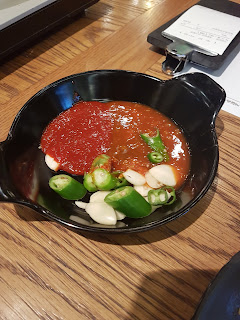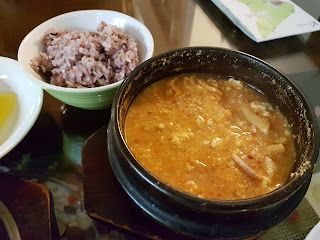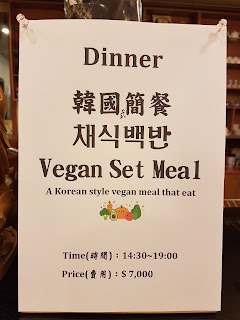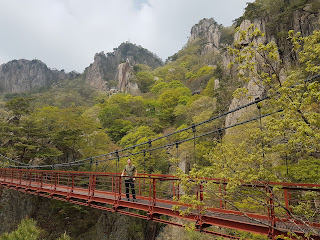It was the 1 May and we were taking another day trip, this time to Maisan.
Maisan, literally "horse-ear mountain", is a mountain to the east of Jeonju. From far, you see two peaks raising from a flat plains and they looked like horse ears, hence the name.
Beside its geologically interesting feature, it is home to an unusual temple -- Tapsa, and that was were I was headed.
 |
| The Maisan has two peaks that are shaped like horse ears. |
Getting there
Based on information found on the internet, there is a direct bus from Jeonju to Maisan's southern car park from a bus stop outside the Jeonju railway station.
We made our way to the train station and dropped by the Tourist Information center. The staff there spoke English and we were given a slip of paper with details about the transport to Maisan.
 |
| The bus schedule posted on the bus stop facing Jeonju Railway Station. The destination is Tapsa, not Maisan. |
 |
| This is the small slip of transport information to Maisan I got from the Tourist Information booth outside the Railway Station. |
We waited at the bus stop for the 9:40 bus. The bus was late and arrived about 9:50. It was a mini bus that turned in from Baekje-daero. The bus did not have a number. Its sign said Tapsa in Hangul, which is the famous temple in Maisan. T-money is accepted, but you need to tell the driver your destination first and wait for the driver to key in your fare before tapping. I told the driver "Tapsa" and was charged 3050 won on my T-money card. (I think the fare is 3100won, but if you use T-money, you get a 50won discount).
One hour later, we were at the southern carpark of Maisan.
There is an park entrance fee of 3000 won and only cash is accepted.
We passed by a stall selling red bean pastry and got some to snack on. But I was disappointed as these were no way close to what I had in Jogyesa in Seoul before. It wasn't cheap either: 10 pieces for 4000 won (it's essentially the same as those fish shape pastries that are sold at 3 pieces for 1000 won in Seoul).
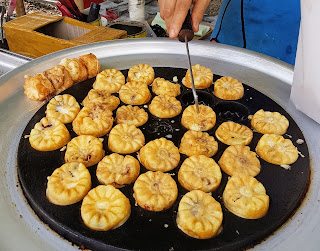 |
| I thought these would make a nice snack but was sorely disappointed. I had better ones in Seoul before. 10 pieces for 4000 won. |
There is a temple just beyond the entrance, but most people are here to visit Tapsa and gave the temple a miss.
 |
| There is a statue of Maitreya Buddha in front of the temple |
 |
| Temple near the southern entrance of the park |
 |
| Sauces fermenting in the shade of a tree. |
It was basically a walk in park from the southern car park to Tapsa. There were a lot of people probably because it was a public holiday.
 |
| The trail passed by a small lake. You can see the 2 "ears" in the distance. |
Tapsa 塔寺
And then we were at Tapsa.
Tapsa is not a big temple. Its temple halls are small and there are no big Buddha statues. Nonetheless, it is an impressive temple, due to its location under an overhanging cliff and the pagodas stacked from stones within its temple grounds.
The stone pagodas are what gave the temple its name: Tapsa literally means Pagoda Temple (塔寺).
It is quite a beautiful and unusual temple.
I was thoroughly amazed when I realized that the stone pagodas are really just stacked stones -- there is no cement or binder to hold the stones together. You can see through the gaps between the stones.
It's amazing the pillars are still standing after so long. I wondered if any of the pillars had been toppled by tourists before.
I saw a few tourist wondering at the pillars and softly pushing them to see if they sway.
 |
| Cute statues under the cliff |
 |
| A giant vine that grew on the walls of the cliff. It looks dead, but is actually alive. |
 |
| The main shrine hall (Hall of the Great Hero 大雄宝殿) is small, but beautifully adorned. |
 |
| The two biggest stone pagodas/stupas representing heaven and earth. |
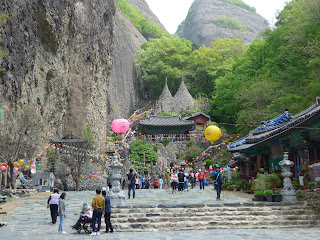 |
| The small temple is sandwiched in a narrow valley between the two peaks. |
 |
| There is a natural fountain. I saw people drinking from it. |
 |
| There were many small statues nestling in crevices on the cliff wall. |
Eunsusa (Silver Water Temple 银水寺)
There is another temple Eunsusa just behind Tapsa. I found this a beautiful temple too. It is not as crowded since most people just passed it on their way to Tapsa from the northern car park.
Eunsusa (Silver Water Temple 银水寺) is at the base of the two peaks of Maisan. Here's you can see the two peaks clearly. There is an ancient pear tree in the ground.
There are also a few telescopes for you to observe the geological features on the cliffs of Maisan.
Watch out for a signboard that explained the geological features as well as an interesting phenominon that happens during winter: if you place a basin of water out here, you will get an icicle growing skyward. There is supposedly no scientific explanation for it. I found one through Google: https://seabrookeleckie.com/2008/02/04/icicles-in-reverse/
 |
| Eunsusa and one of the "horse ears" peak behind it. |
 |
| The Hall of Infinite Light. Here you can see the gap between the two peaks of Maisan. The trail between the temple and the northern carpark passes through the gap. |
 |
| Sauces fermenting under the sun in Eunsusa |
 |
| The cliff face is full of holes that are result of weathering. This is known as "tafoni" (or honeycomb weathering) and is supposedly the most well formed tafoni in the world. |
Heading back
After Eunsusa, we were ready to head back. It had been a walk through mostly flat terrain coming from the southern car park so I wasn't quite expecting to be going upward.
What I found out later was that the path between the northern car park and Tapsa cuts through the "mountain pass" or the trough between the two peaks of Maisan. The southern car park was also on higher grounds compared with the northern carpark. If you are coming from the northern carpark, it actually involved quite a bit of climb.
At the pass, there is a rest area and an interesting feature that shows the watershed point. There is also a trail up one of the peak but we didn't go up.
 |
| A feature showing the water shed point at the mountain pass between the two peaks of Maisan. |
Now, my partner who does not work out much was suffering from muscle ache from the previous day's hike. So it was difficult going down the stairs. Luckily, just a short distance down from the pass, we saw a sign about a tram service. We checked it out and indeed there was a tram service.
We paid 3000won each for the trip down the mountain to the northern carpark.
There is a bus stop next to the tram station for buses to Jinan (there were a few bus stop within the large compound). I took a look at the schedule posted at the bus station.
It was 13:45 and we had just missed bus. So we planned to catch the 14:40 bus and get some lunch in the mean time.
 |
| The tram road leading to the trail up the mountain pass. The tram station on the right. Many people took the tram instead of walking up. the green shelter behind the tram station is one of the bus stop for buses to Jinan |
 |
| The bus schedule posted inside the bus stop. The bus runs almost hourly, except for 9am and 3pm. I was careless and thought the bus leaves at 40 min past the hour. |
Lunch was dolsot sanchae bibimbap with deonjang jiggae again (9000won a set). I was starting to get sick of bibimbap...
When we get back to the bus stop at 14:35, I suddenly realized I had read the schedule wrongly! The bus departed at 14:30, not 14:40! 14:40 was the expected arrival time at Jinan!
There was no bus scheduled at 15:30. The next one was 16:30!
I wasn't prepared to wait for 2 hours. So we went to the Information center and an English speaking staff helped us called a cab. It arrived within 5 minutes. Jinan is actually very near. The cab ride only took 5 minutes and cost us 4000won. It wasn't expensive since a bus ride would cost 1300 won each anyway. That saved us two hours of waiting time. From my estimate, it would be possible to walk to the Jinan bus terminal within 30 min.
On hindsight, it might have been better to walk back to the southern carpark and catch the 14:05 bus to Jinan instead.
From Jinan, there were frequent buses back to Jeonju (3700 won). We boarded a bus within 10 mins and one hour later, we were back at Jeonju Inter City Bus Terminal.
We rested for a while in the hotel and then went back to the Veteran restaurant in Hanok village for dinner.
 |
| Maisan in the distance, seen from the bus on the way back to Jeonju |









